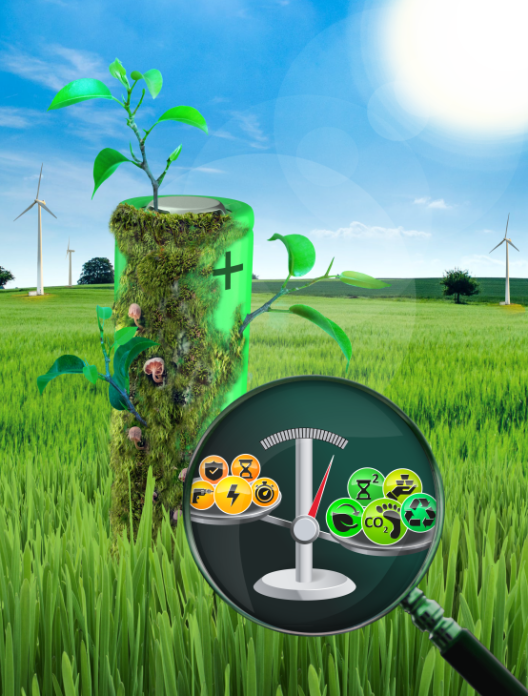Improving the carbon footprint of batteries

Climate and resources protection are among the most important challenges of our time. Two main pillars for reducing CO2 emissions worldwide are electromobility and electricity from renewable energy resources. Efficient electrochemical energy storage systems are essential for both. Lithium ion batteries (LIB) currently dominate the market, as they combine high energy density and long life cycle with consumer-acceptable safety and economy. But what about their own sustainability?
Alternative materials for a "green" battery
In particular, the production process of the LIB currently still requires a lot of energy. In addition, some of its raw materials are critical. In order to improve the carbon footprint of the battery cell, its entire life cycle must be made sustainable: from the selection of raw materials and their transport to production, cell disposal and recycling. The status quo of the LIB from the point of view of sustainability as well as the possibilities of producing a "green" battery with alternative materials have been analyzed in detail by MEET scientists around Dr. Simon Dühnen. The investigation focused on the availability of raw materials in the long term, and how different battery materials and technologies affected the sustainability and energy balance of the entire life cycle.
The approaches for sustainable materials are manifold. For example, cobalt in the cathode of the LIB is to be replaced in the long term, as the raw material is scarce and one of the cost drivers in production. Furthermore, the conditions during mining are considered questionable. However, alternatives - for example organic cathode materials that are free of transition metals - are currently failing due to their low energy density and their instability in classical electrolytes of the LIB. "This example shows the great challenge of switching to greener materials. As soon as we replace one component, it affects all components of the battery cell and thus its performance," says MEET scientist Dr. Simon Dühnen. A sustainable energy storage system that can compete with the performance and reliability of a LIB therefore does not currently exist.
Application of the battery decides on sustainability strategy
"With the right strategy, we can still improve the carbon footprint of batteries”, emphasizes Dühnen. He differentiates between the different applications. In the case of mobile storage technologies, which are used in electric cars for example, energy density and performance are crucial and a departure from LIB is therefore currently not conceivable. This makes it even more important to recycle their materials stringently. In addition, since many batteries from mobile devices are not used to the end of their capacity, they should be transferred to a second, often stationary application ("second life"). This spreads the CO2 emissions of the battery over a longer period.
Stationary energy storage systems, which for example secure electricity from renewable energy resources, have a greater scope in terms of weight and size. "We need a lot of active material in such batteries that can be stored," explains Dühnen. "Sustainably available materials such as sodium and sulfur or renewable raw materials can therefore play a decisive role in this area. This makes it essential to continue research into alternative battery technologies".
A detailed analysis of which materials are suitable for a "green" battery and where their strengths and weaknesses lie can be found in the open access review article in the current issue of the specialist magazine "Small Methods". In close cooperation, MEET scientists Dr. Simon Dühnen, Johannes Betz, Martin Kolek, Dr. Richard Schmuch, Prof. Dr. Martin Winter and Dr. Tobias Placke have compiled the analyses and results for this.

